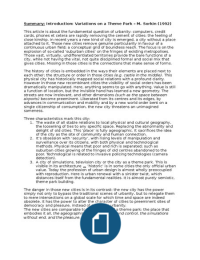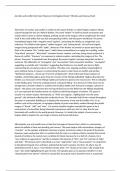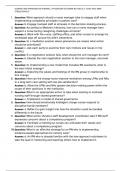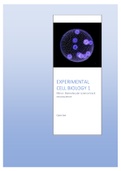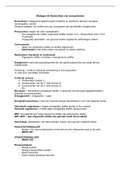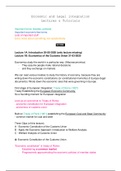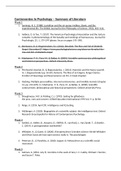Summary class 1: Introduction Romanticism
- Romantic lit in ba1: Keats, Wordsworth (pioneer romantic poet, Lyrical ballad), Coleridge
- Most important written in English 1800-1850: Moby Dick
- 1850-1900: George Eliot - Middlemarch
- We will deal with excerpts – but feel free to read the whole works
This semester:
- Romantic poetry, the Romantic novel
- the American Renaissance
- the slave narrative (last class)
This week:
- the “Long Nineteenth Century”
- features of Romanticism
- practical info
Introduction
The Fighting Temeraire (1838, Turner)
- famous English battle against Napoleon
- Typical interpretation: about death, tragic heroism, ship is destroyed, depicted as a ghost
ship
- Smoke stack in the middle >< natural environment
- Nature as a representation of the divine
- Prominent divine ship pushed in the background by ‘industrial’ ship with smoke stack
- Background: mystical light, emphasis on light
- Experimental painting at the time (>< neoclassicism) heavy brush strokes, can be seen as
primitive form of impressionism
- Historical topic, emphasis on nature, the divine, = also elements in literature
(Constable painting, slide 2)
- Revolutionized landscape painting
- Primitively impressionistic, brush strokes, distorted clouds and city, foreground is not just
landscape, also small person (but not in center, not important)
The “Long Nineteenth Century”
- Term for this new period that changed the way that people lived, the world was very
different from what came before and not so different from what came after
- Started before 1800 (1789, French Revolution = beginnings of democracy) and ended after
1900 (1789-1914 are possible dates: °FRev and WWi)
- Hobsbawm wrote a book about this and introduced this term
- Walter Scott = inventor of the historical novel (in Flanders equivalent: Hendrik Conscience)
- American Renaissance indirectly inspired by Walter Scott, same emphasis on nationalism,
own literature
,Age of Revolution Age of Capital Age of Empire (Hobsbawm)
- Industrial revolution, American revolution 1776, French revolution 1789, Belgian
Revolution 1830
>> still affect our lives today! (democracy, voting rights, welfare state, all rooted in this era)
- American Revolution influenced the French & Belgian, and the American constitution
influenced those constitutions (Belgian was the most radical constitution at the time)
- difference FRev and AmRev? FRev failed! But is still remembered as the beginning of
democracy – started as a good cause but then began ‘eating its own children’: e.g.
Robespierre – revolutionists becoming paranoid once they had gained power – also
Napoleon became consul and then emperor = end of the small beginnings of democracy
>> Napoleon: megalomaniac ambition that was bound to fail (but Romantics like Byron
looked up to him – cf. cult of the genius)
>> Napoleon defeated –FRev came back, people were protesting again > BelRev, another
FRev in 1830 (first signs of enlightened despotism), and another in 1848 (Napoleon III elected
as president but emperor in 1852…)
- Another revolution that Romantics admired: e.g. Coleridge went to US and started his own
Utopia (like many, but everyone always failed)
- Why revolutions are so important in this period (Belgium, Germany, Italy, …): The nation
state replaced the ancien regime (Belgium was talked about under the reign of the
Netherlands, Austria…, but never as a real country): nationalism became important
Romanticism
- Narrative theory, the representation of the mind are tools that are rooted in romanticism
- poetry and the cult of genius: Shelley wrote poetry is something like the divine, immortal,
the poet is the genius capable of bringing out the divine – poets are the only true legislators
in this world – and admired figures like Napoleon and overreaching, overambitious
characters like Faust)
- experimentation and consolidation: the Romantic novel, the American Renaissance
>> much consolidation but at the same time innovation in prose by authors like Melville,
Mary Shelley (perfected the gothic novel, first sci-fi novel), Jane Austen (perfected the novel
of manners: focus on representation of the mind, how her characters try to read each others
minds, intentions – represents how we read fiction, the minds of characters)
mid-Victorian era, the American Civil War
- realism, social panoramas
- growth of the British Empire, end of slavery in the U.S.
late Realism, early modernism
- disillusion, questioning of omniscience (Darwin, Marx, Nietzsche, Freud)
>> Contemporary literature: focus on representation of the mind (psychology) also rooted
in the era of Romanticism
>> Modernism = ‘make it new’ , but the Romantics at the time were equally revolutionary,
also breaking the conventions (e.g. cult of the genius)!
- naturalism, psychological realism
Age of Revolution
William Blake – “London” (1789-1794)
, I wander thro’ each charter’d street, L1: wander = typical romantic word? Charter
Near where the charter’d Thames does (=set of rules, imposed regulations >< freedom)
flow. L2: Thames is not a natural thing anymore, it is
And mark in every face I meet chartered > nature is being controlled by
Marks of weakness, marks of woe. humans
L8: Key phrase (lay out: in the middle): mind
In every cry of every Man, forged manacles - we are no longer natural
In every Infant’s cry of fear, beings, we are corrupted by society: cf.
In every voice: in every ban, Rousseau > idealization of the savage, the
The mind-forg’d manacles I hear primitive person or the child (not yet corrupted
by society, closer to nature – the Noble savage)
How the Chimney-sweeper’s cry >> Child: we are born free but enslaved by
Every blackning Church appalls, society (phrase by Shelley)
And the hapless Soldier’s sigh L9: Chimney sweepers cry, black church: ref to
Runs in blood down Palace walls IR, but symbolical ref to institutional religion (><
the divine, sublime – church’ regulations
But most thro’ midnight streets I hear corrupt the soul + many churches’ walls were
How the youthful Harlots curse blackened from coal? – many Romantics were
Blasts the new-born Infant’s tear anti church or even atheist)
And blights with plagues the Marriage Ll11-12: Soldiers, blood – refs to war and
hearse violence (revolutionary wars, not a positive
reference)
L15: Infant: child torn away from his innocence
L16: Marriage = the covenant (key) between
god and man/artist (the promise we have to
keep to God and he to us)
Romanticism?
literary history vs. chronology
- What is romanticism?: term did not exist at the time
- different meanings for different people: e.g. Walter Scott is much more archaic than Austen
- We need to remember that we are looking back at a historical canon: Austen, Keats, Shelley,
Byron, Melville largely unknown (Moby Dick was a failure) Wordsworth very ambitious but
new, would become much more known later in life
- we should not confuse literary romanticism with the concept as we know it today
the canon
- We have to be critical of that canon – Barbauld is an exception, she was really famous and
then fell into obscurity, and then rediscovered when feminist lit became popular again
- Own time: Scott = really famous >< Austen: hardly left her country house
- Our time: Scott = very much part of canon back then, much less so today >< Austen
British Romanticism vs. American Romanticism
- Romanticism is a dubious term, a term used in hindsight, and a broad term
- English Romanticism > German Romanticism (Schilling, Kant as preromantic figures, notion
of the romantic sublime (that which we cannot see, we should not speak of))
- Romanticism was a term in German culture at the time, not in English literature until second
half of 19th century
, - From German to English culture primarily through Coleridge (wrote poetry but also essays
and theoretical works about poetry)
- American Rom > from British romanticism, but different, came much later, ca. 1848-9-50
why? because American literature from 1850s (except Poe, who was mainly read in
Europe) came into its own with the American RE: writers calling for a literature of
their own, establish an American imagination (eg Last of the Mohicans, Legends of
Sleepy Hollow, typical American stories – about a young, rugged country, eg about
contact with Natives - not this high type of English Romanticism)
but it arrived in a burst (Hawthorne, Emerson, Melville), remember that all of these
writers were writing with a common canon in mind, knew each other personally and
lived close by (New England = also where AmRev started, they were conceptualizing
a national literature)
attitudes toward “revolution”
- Americans were all inspired by revolutions, and they wanted to do the same for literature
(England was not as progressive as other countries, 1 figure who stands out on this matter is
Lord Byron, least ‘romantic’ of all, he was a very progressive member of the house of Lords)
- The slave narrative (Frederick Douglas): the Big word in Am RE = self-reliance (also theme in
Moby Dick) Douglas wasn’t born free and so self-reliance was extremely important to him
but in a different sense
Features of Romanticism:
- As one, large cultural phenomenon, but not all features apply to all authors
- See how these return with some writers and which ones are missing
- Useful list to study + keep in mind when reading!
- There will be questions about this on the exam!
- Firm knowledge of texts & how they relate to romanticism!
emancipation of the individual
- Artistic: much of artworks were not only seen as mere ‘crafts’, focus on the artist as an
inspiring genius, focus on the content (divine, sublime) = positive thing, but also negative
because some of them who saw themselves as geniuses became recklesses (the artist
reckless, living on their own) – being an author, genius artist >< writer
- Political:
1. Big difference between romantics and neoclassicists (swift, Pope, 18 th c): less archaic,
more focus on style, but now works of art became products in an economic market,
definitely in American society (after AR: no longer EN copyright laws, so all these
American authors had to compete with free English literature, there was also no
nobility anymore, no clergy anymore)
2. Difference Am-EN: Many EN romantics lived in oblivion: Keats, Austen, rich authors like
Byron, Coleridge, Shelley did not have to make their own money, could afford to live as
a wandering poet
3. more readers in 19thC: audience expanded enormously, Technological improvements in
printing, more individual incomes pp, More female writers, writing about feminist issues
4. the rights of man & women were new, democratic emphasis in romantic works, poets
became political, produced manifestos, theorized poetry (‘poets are the
unacknowledged legislators of the world”)
- Romantic lit in ba1: Keats, Wordsworth (pioneer romantic poet, Lyrical ballad), Coleridge
- Most important written in English 1800-1850: Moby Dick
- 1850-1900: George Eliot - Middlemarch
- We will deal with excerpts – but feel free to read the whole works
This semester:
- Romantic poetry, the Romantic novel
- the American Renaissance
- the slave narrative (last class)
This week:
- the “Long Nineteenth Century”
- features of Romanticism
- practical info
Introduction
The Fighting Temeraire (1838, Turner)
- famous English battle against Napoleon
- Typical interpretation: about death, tragic heroism, ship is destroyed, depicted as a ghost
ship
- Smoke stack in the middle >< natural environment
- Nature as a representation of the divine
- Prominent divine ship pushed in the background by ‘industrial’ ship with smoke stack
- Background: mystical light, emphasis on light
- Experimental painting at the time (>< neoclassicism) heavy brush strokes, can be seen as
primitive form of impressionism
- Historical topic, emphasis on nature, the divine, = also elements in literature
(Constable painting, slide 2)
- Revolutionized landscape painting
- Primitively impressionistic, brush strokes, distorted clouds and city, foreground is not just
landscape, also small person (but not in center, not important)
The “Long Nineteenth Century”
- Term for this new period that changed the way that people lived, the world was very
different from what came before and not so different from what came after
- Started before 1800 (1789, French Revolution = beginnings of democracy) and ended after
1900 (1789-1914 are possible dates: °FRev and WWi)
- Hobsbawm wrote a book about this and introduced this term
- Walter Scott = inventor of the historical novel (in Flanders equivalent: Hendrik Conscience)
- American Renaissance indirectly inspired by Walter Scott, same emphasis on nationalism,
own literature
,Age of Revolution Age of Capital Age of Empire (Hobsbawm)
- Industrial revolution, American revolution 1776, French revolution 1789, Belgian
Revolution 1830
>> still affect our lives today! (democracy, voting rights, welfare state, all rooted in this era)
- American Revolution influenced the French & Belgian, and the American constitution
influenced those constitutions (Belgian was the most radical constitution at the time)
- difference FRev and AmRev? FRev failed! But is still remembered as the beginning of
democracy – started as a good cause but then began ‘eating its own children’: e.g.
Robespierre – revolutionists becoming paranoid once they had gained power – also
Napoleon became consul and then emperor = end of the small beginnings of democracy
>> Napoleon: megalomaniac ambition that was bound to fail (but Romantics like Byron
looked up to him – cf. cult of the genius)
>> Napoleon defeated –FRev came back, people were protesting again > BelRev, another
FRev in 1830 (first signs of enlightened despotism), and another in 1848 (Napoleon III elected
as president but emperor in 1852…)
- Another revolution that Romantics admired: e.g. Coleridge went to US and started his own
Utopia (like many, but everyone always failed)
- Why revolutions are so important in this period (Belgium, Germany, Italy, …): The nation
state replaced the ancien regime (Belgium was talked about under the reign of the
Netherlands, Austria…, but never as a real country): nationalism became important
Romanticism
- Narrative theory, the representation of the mind are tools that are rooted in romanticism
- poetry and the cult of genius: Shelley wrote poetry is something like the divine, immortal,
the poet is the genius capable of bringing out the divine – poets are the only true legislators
in this world – and admired figures like Napoleon and overreaching, overambitious
characters like Faust)
- experimentation and consolidation: the Romantic novel, the American Renaissance
>> much consolidation but at the same time innovation in prose by authors like Melville,
Mary Shelley (perfected the gothic novel, first sci-fi novel), Jane Austen (perfected the novel
of manners: focus on representation of the mind, how her characters try to read each others
minds, intentions – represents how we read fiction, the minds of characters)
mid-Victorian era, the American Civil War
- realism, social panoramas
- growth of the British Empire, end of slavery in the U.S.
late Realism, early modernism
- disillusion, questioning of omniscience (Darwin, Marx, Nietzsche, Freud)
>> Contemporary literature: focus on representation of the mind (psychology) also rooted
in the era of Romanticism
>> Modernism = ‘make it new’ , but the Romantics at the time were equally revolutionary,
also breaking the conventions (e.g. cult of the genius)!
- naturalism, psychological realism
Age of Revolution
William Blake – “London” (1789-1794)
, I wander thro’ each charter’d street, L1: wander = typical romantic word? Charter
Near where the charter’d Thames does (=set of rules, imposed regulations >< freedom)
flow. L2: Thames is not a natural thing anymore, it is
And mark in every face I meet chartered > nature is being controlled by
Marks of weakness, marks of woe. humans
L8: Key phrase (lay out: in the middle): mind
In every cry of every Man, forged manacles - we are no longer natural
In every Infant’s cry of fear, beings, we are corrupted by society: cf.
In every voice: in every ban, Rousseau > idealization of the savage, the
The mind-forg’d manacles I hear primitive person or the child (not yet corrupted
by society, closer to nature – the Noble savage)
How the Chimney-sweeper’s cry >> Child: we are born free but enslaved by
Every blackning Church appalls, society (phrase by Shelley)
And the hapless Soldier’s sigh L9: Chimney sweepers cry, black church: ref to
Runs in blood down Palace walls IR, but symbolical ref to institutional religion (><
the divine, sublime – church’ regulations
But most thro’ midnight streets I hear corrupt the soul + many churches’ walls were
How the youthful Harlots curse blackened from coal? – many Romantics were
Blasts the new-born Infant’s tear anti church or even atheist)
And blights with plagues the Marriage Ll11-12: Soldiers, blood – refs to war and
hearse violence (revolutionary wars, not a positive
reference)
L15: Infant: child torn away from his innocence
L16: Marriage = the covenant (key) between
god and man/artist (the promise we have to
keep to God and he to us)
Romanticism?
literary history vs. chronology
- What is romanticism?: term did not exist at the time
- different meanings for different people: e.g. Walter Scott is much more archaic than Austen
- We need to remember that we are looking back at a historical canon: Austen, Keats, Shelley,
Byron, Melville largely unknown (Moby Dick was a failure) Wordsworth very ambitious but
new, would become much more known later in life
- we should not confuse literary romanticism with the concept as we know it today
the canon
- We have to be critical of that canon – Barbauld is an exception, she was really famous and
then fell into obscurity, and then rediscovered when feminist lit became popular again
- Own time: Scott = really famous >< Austen: hardly left her country house
- Our time: Scott = very much part of canon back then, much less so today >< Austen
British Romanticism vs. American Romanticism
- Romanticism is a dubious term, a term used in hindsight, and a broad term
- English Romanticism > German Romanticism (Schilling, Kant as preromantic figures, notion
of the romantic sublime (that which we cannot see, we should not speak of))
- Romanticism was a term in German culture at the time, not in English literature until second
half of 19th century
, - From German to English culture primarily through Coleridge (wrote poetry but also essays
and theoretical works about poetry)
- American Rom > from British romanticism, but different, came much later, ca. 1848-9-50
why? because American literature from 1850s (except Poe, who was mainly read in
Europe) came into its own with the American RE: writers calling for a literature of
their own, establish an American imagination (eg Last of the Mohicans, Legends of
Sleepy Hollow, typical American stories – about a young, rugged country, eg about
contact with Natives - not this high type of English Romanticism)
but it arrived in a burst (Hawthorne, Emerson, Melville), remember that all of these
writers were writing with a common canon in mind, knew each other personally and
lived close by (New England = also where AmRev started, they were conceptualizing
a national literature)
attitudes toward “revolution”
- Americans were all inspired by revolutions, and they wanted to do the same for literature
(England was not as progressive as other countries, 1 figure who stands out on this matter is
Lord Byron, least ‘romantic’ of all, he was a very progressive member of the house of Lords)
- The slave narrative (Frederick Douglas): the Big word in Am RE = self-reliance (also theme in
Moby Dick) Douglas wasn’t born free and so self-reliance was extremely important to him
but in a different sense
Features of Romanticism:
- As one, large cultural phenomenon, but not all features apply to all authors
- See how these return with some writers and which ones are missing
- Useful list to study + keep in mind when reading!
- There will be questions about this on the exam!
- Firm knowledge of texts & how they relate to romanticism!
emancipation of the individual
- Artistic: much of artworks were not only seen as mere ‘crafts’, focus on the artist as an
inspiring genius, focus on the content (divine, sublime) = positive thing, but also negative
because some of them who saw themselves as geniuses became recklesses (the artist
reckless, living on their own) – being an author, genius artist >< writer
- Political:
1. Big difference between romantics and neoclassicists (swift, Pope, 18 th c): less archaic,
more focus on style, but now works of art became products in an economic market,
definitely in American society (after AR: no longer EN copyright laws, so all these
American authors had to compete with free English literature, there was also no
nobility anymore, no clergy anymore)
2. Difference Am-EN: Many EN romantics lived in oblivion: Keats, Austen, rich authors like
Byron, Coleridge, Shelley did not have to make their own money, could afford to live as
a wandering poet
3. more readers in 19thC: audience expanded enormously, Technological improvements in
printing, more individual incomes pp, More female writers, writing about feminist issues
4. the rights of man & women were new, democratic emphasis in romantic works, poets
became political, produced manifestos, theorized poetry (‘poets are the
unacknowledged legislators of the world”)

